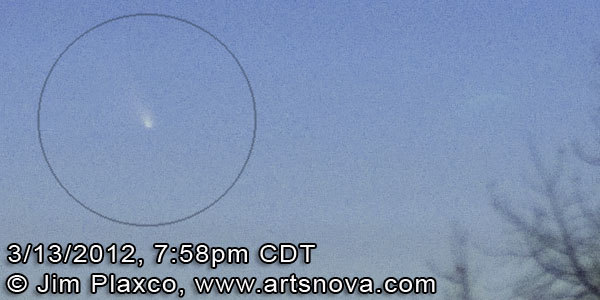Comet Spotting: Pan-STARRS

Comet Pan-STARRS as viewed from Schaumburg IL, 3/13/13
Last night I headed to an artificial hill constructed by the Schaumburg Park District that is probably the highest ground location relative to the surroundings within a 20 minute drive of my home. From that outdoor perch I had hopes of seeing Comet Pan-STARRS.
I was in place observing at about 20 minutes after sunset – about 7:20pm. Pan-STARRS would be setting at 8:18pm so I had one hour to hunt. I had not brought binoculars with me – only my camera. Almost as annoying as the bright sky was the cold. Standing in an exposed position on the top of a hill in 20 degree weather is not my cup of tea.
I looked to the horizon with some trepidation. The combination of haze and horizon glow made for a very bright sky. And street lights in the foreground didn't help. The only celestial object I could see on the western horizon was the Moon. Below the Moon, nothing. No stars, no Mars – just glow. With a magnitude of 0.9 (the magnitude of Mars is a slightly dimmer 1.2) I has serious doubts as to whether or not I would see Pan-STARRS.
A couple times I thought I detected it using averted vision but in hindsight I think it was unlikely. Over the course of my observing I would periodically take a slightly overexposed photograph to see if I could find Pan-STARRS with my camera. I saw nothing.
Hands numb, I packed up my camera and tripod at 8:15pm and headed home. Popping my camera's SD card into the computer I was elated to see Comet Pan-STARRS. Once I had the RAW file opened in Photoshop, I duplicated the background layer and set the duplicate layer's blend mode to multiply. This darkened the sky significantly while leaving the comet's brightness unchanged – thus greatly increasing the degree of contrast between the comet and the background sky.
A cropped full resolution section of the processed source photograph is used to illustrate this story. You can view the entire photograph here:
Full resolution processed source photograph of Comet Pan-STARRS
In the photo, taken at 7:58pm, you can see just how close Pan-STARRS was to the horizon. The fact that it was almost directly above a street light certainly made it more difficult for my eyes to see it. In the linked photograph, Pan-STARRS as well as a few of the brighter stars are identified with their name appearing slightly above and to the right of the associated object. Here is a link to the star chart I used for identifying the stars in the photograph:
Star chart showing Pan-STARRS on March 13 from Schaumburg IL
Hopefully there will be clear skies this Saturday at Yerkes Observatory and hopefully I'll be able to find the time to observe Pan-STARRS from that location. The timing will be difficult as I am slated to give a presentation from 7:15 to 7:45pm – prime time for observing Pan-STARRS. Wish me luck.
Ad Astra, Jim
| Return to the Blog Index | This entry was posted on Thursday, March 14th, 2013 at 9:40 am and is filed under Astronomy.